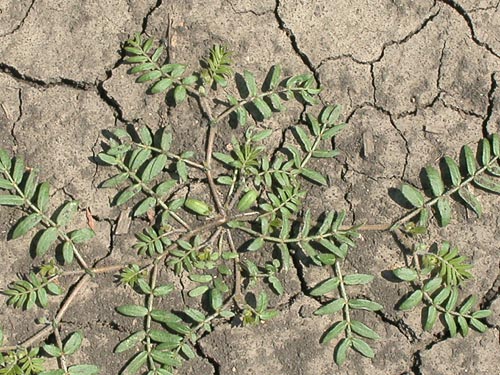Weeds
Tribulus terrestris L. - Puncture Vine
Systematic position.
Family Zygophyllaceae, genus Tribulus L.Biological group.
Annual weed.Morphology and biology.
Annual, grayish, hairy plant having thin root. Stalks 10 to 50 cm in length, prostrate, branchy from base, pubescent. Leaves opposite, conjugate-pinnate, 2-6 cm in length, with small lanceolate stipules at base; 5-8 pairs of leaflets, 7-13 mm in length, 2-5 mm in width, almost sessile, oblong, blunt. Flowers not numerous, small, single, located on short upward pedicels in leaf sheaths; perianth easily falling. Calyx consisting of 5 sepals; sepal elongate-pointed, with decumbent hairs outside, 4-5 mm in length, 1-1.5 mm in width. Corolla consisting of 5 petals; petal yellowish, obovoid, truncated at apex, 5-7 mm in length, 3 mm in width. 10 stamens attached to the base of a ring-shaped disk, of which 5 stamens alternating with petals and having a glandule at base. Column with 5-lobed blunt stigma. Fruit 10-15 mm in diameter. It consists of 5 stellately located fruitlets, each divided inside by septa into 3-5 cells. The fruitlets covered outside with 2-4 strong and sharp thorns, tubercles, and bristles. Seeds 2.5-3 mm in length, ovoid, light brown. Blossoms May until autumn. Fructifying in August - November. Fruitfulness to 5,000 fruits. Weight of 1,000 seeds about 3-6 g. Seeds sprout from depth of no more than 12-15 cm.Distribution.
The species originates from the Mediterranean, but now a cosmopolitan due to seed transfer, meeting in a warm zones of all parts of the world. In the former USSR it is distributed in southern areas of the European part, in the Caucasus, Western Siberia (Altai), Eastern Siberia (south), Central Asia.Ecology.
The plant grows along roads, at buildings and fences, in river valleys on sandy banks, on pastures, waste grounds, common pastures, old fallows, and weed places. It prefers sandy soils.Economic significance.
The weed meets on irrigated and dry fields of wheat, barley, cotton, other irrigated and tilled cultures, being common weed in melon and gourd cultures, sometimes in alfalfa fields. The Puncture Vine is the main weed of vegetable cultures in southern and southeastern droughty areas. It creeps between cultural plants in second half of summer when it is hardly eradicable. Control measures include the weed eradication by stubbling, intertillage, undercutting, and hoeing. It is necessary to prevent the Puncture Vine flowering.Reference citations:
Artokhin, K.S. 2004. Atlas of weed plants. Rostov-na-Donu: Kniga, 144 p. (in Russian).Grossgeim, A.A. 1949. Keys to plants of the Caucasus. Moscow: Sovetskaya nauka, 747 p. (in Russian).
Shishkin, B.K., ed. 1963. Botanical atlas. Moscow & Leningrad: Selkhozgiz, 504 p. (in Russian).


